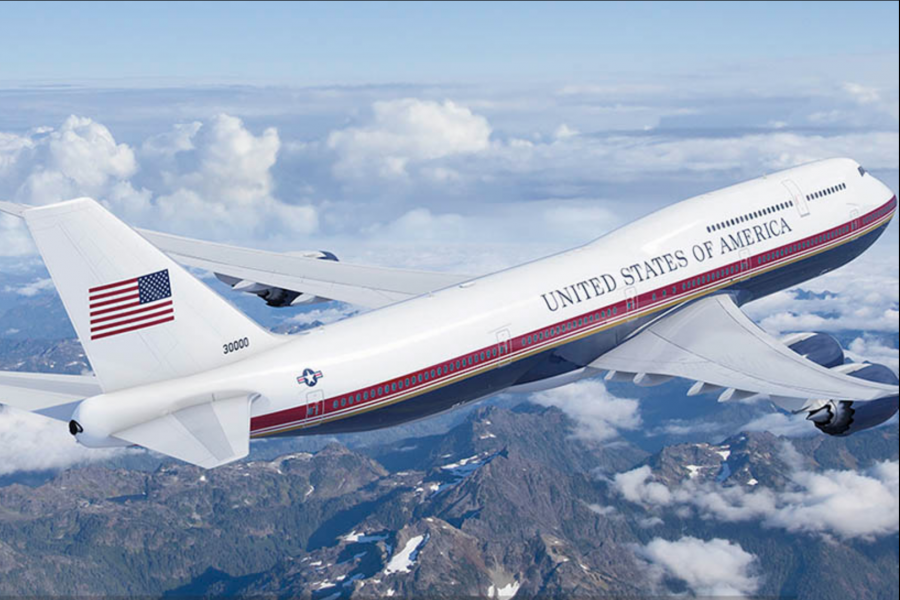If Boeing shuts down production of the 747 series of airliners/freighters, the Air Force does not expect supply or support issues with the current or future versions of Air Force One—the presidential transport based on the 747—or the E-4B National Airborne Operations Center.
There’s no need to panic-buy 747 components, a USAF spokesman said. The service “does not envision a need to procure parts early” for the 747-based aircraft because Boeing’s supply chain “will still be available to support the current, operational, worldwide 747 fleet” for many years, he said.
Bloomberg reported earlier this month that Boeing will “pull the plug” on 747 production within two years, given declining demand for the iconic, four-engined airplane. Boeing only makes six 747s a year, and while demand for the jet has slowed in recent years, the COVD-19 pandemic is accelerating cost-cutting measures.
“At a build rate of half an airplane a month, the 747-8 program has more than two years of production ahead of it in order to fulfill our current customer commitments,” according to a Boeing spokesperson. “We will continue to make the right decisions to keep the production line healthy and meet customer needs.” He declined to say whether the line would end at that point.
The Air Force has two 30-year-old VC-25As, based on the 747-200, which by congressional mandate must retire in five years. Boeing is under contract to convert two somewhat larger 747-8s to VC-25B configuration, and they are expected to serve as the presidential transports from 2025 until 2055.
“As part of normal planning for VC-25 activation, the program office recently released a request for proposal to Boeing for long-lead spares procurement,” the spokesman reported. The program office will work with the company to “ensure all necessary spares are available to support” the two VC-25Bs across their life expectancy.
At the behest of the White House, the Air Force sought money-saving options for the VC-25B program, and the service accomplished that in part by buying two complete “white tail” 747-8s without interiors that were parked, never having been delivered to their intended customer, a Russian airline, which canceled its order. Boeing is configuring the aircraft with all the executive amenities, self-protection systems, and the extensive secure communication suite required to be a flying White House.
As for the E-4B, of which the Air Force operates four airplanes, the service doesn’t anticipate “a significant impact from the 747-8 production line shutdown.” The service “actively reviews the supply base for diminishing sources or obsolescence issues associated with the E-4B 747-200 configuration and works with Boeing to develop mitigation strategies” to resolve any issues, the spokesman said.
As for the future of the E-4B, the service is waiting on completion of a joint-service analysis of alternatives, due by the end of this year, on how to most effectively replace the E-4B, the Navy’s E-6 Mercury TACAMO (Take Charge and Move Out) nuclear command and control aircraft, which is based on the 707, and the C-32, a Boeing 757-derived executive transport often used to transport the vice president or senior Administration officials. It often goes by the callsign “Air Force Two.” The A version of the six-airplane C-32 fleet is used for VIP transport while the two B versions are equipped for discreet crisis response.
The joint-service AOA is looking at “the most suitable alternative for the recapitalization of the large-capacity Executive Airlift and National Military Command System airborne, fixed-wing” fleets, the spokesman said.
A USAF official familiar with the AOA said it’s unlikely the study will come back with a four-engined solution, given the higher efficiency and certain availability of equally long-ranged, two-engined jets. A high-profile battle for a prospective joint USAF/Navy contract is also not expected. “We’re only talking … around 30 airplanes, total, here,” the official said, unlike the Air Force’s KC-X tanker competition between Boeing and Airbus for at least 179 airplanes.
Though Boeing has not officially announced the end of the 747 yet, it has stopped ordering new structural components for the production line, and has reportedly lost money on it for the last four years.
The 747 is one of Boeing’s most iconic airplanes; its size and efficiency ushered in an era of air travel in the 1970s to customers who previously could not afford to fly. It was the only “super jumbo” on the market for 20 years, and about 1,600 will have been built when the line is shuttered.
Boeing is credited with shrewd market analysis in not following up the 747 with an even bigger airplane in the 1990s. The company correctly predicted that the airline industry was becoming more interested in smaller, easier-to-fill, more efficient, two-engined jets having the range to fly direct to more distant cities without enroute stops at central hubs. This drove the development of Boeing’s 777 jumbo and 787 Dreamliner aircraft. Meanwhile, competitor Airbus, looking to steal the super-jumbo cachet from Boeing, pursued the double-decker A380, expecting a strong market for long-haul flights and a parallel market for freighters. That market turned out to be far smaller than anticipated, though, and the plane was a financial bust. The freighter model was canceled and the company will deliver its last A380 airliner in 2021, having built about 250 airplanes over 16 years, at a development cost exceeding $13 billion. Airbus has said it will eventually break even on the A380.
